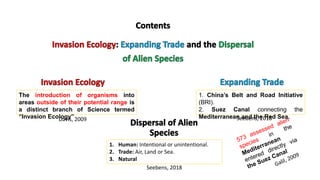Invasion Ecology: Expanding Trade and the Dispersal of Alien Species
- 1. 28th March. 2019 Muhammad Asghar Hassan (Ph.D. Scholar) LB20183190022 Laboratory of Systematic & Evolutionary Entomology, Department of Entomology, College of Plant Protection, China Agricultural University, Beijing Invasion Biology Participants of the ŌĆśŌĆśEcology and Management of Invasive Riparian and Aquatic Plants: an International WorkshopŌĆÖŌĆÖ UK Invasion risks and the New Silk Road.
- 2. 1. ChinaŌĆÖs Belt and Road Initiative (BRI). 2. Suez Canal connecting the Mediterranean and the Red Sea. The introduction of organisms into areas outside of their potential range is a distinct branch of Science termed ŌĆ£Invasion EcologyŌĆØ 1. Human: Intentional or unintentional. 2. Trade: Air, Land or Sea. 3. Natural Davis, 2009 Seebens, 2018 Seebens, 2018
- 5. ChinaŌĆÖs ambitious aspirations to build a modern Silk Road will open new avenues for species to spread into regions outside their native range.
- 6. Source of dispersal ŌĆó By moving cargo, people or ŌĆö more generally ŌĆö vehicles. ŌĆó Humans also move species either intentionally or accidentally. ŌĆó Although the dispersal of species is natural process: essential for the survival of species But the expansion and intensification of trade have increased the spread of species to unprecedented levels and has connected regions which have never been connected before. Suez Canal Construction: B/w1859 and 1869. Route: North Atlantic & northern Indian Oceans.
- 7. Investments in nearly all Asian countries, as well as Africa, Australasia and Europe, it is one of the most ambitious infrastructure projects ever conceived. With a planned expenditure of eight trillion US dollars https://www.nationsonline.org/oneworld/continents.htm https://tradeix.com/benefits-of-blockchain-in- trade-finance/8-trillion-trade-finance/ Continents and Expenditure
- 8. ChinaŌĆÖs Belt and Road Initiative showing China in Red, the six proposed corridors of the Silk Road Economic Belt, a land transportation route running from China to southern Europe via Central Asia and the Middle East, and the 21st Century Maritime Silk Road, a sea route connecting the port of Shanghai to Venice, Italy, via India and Africa. Image by Lommes via Wikimedia Commons (CC BY-SA 4.0). Six proposed corridors of the Silk Road Economic Belt
- 9. 1. Caribbean island. 2. Central America. 3. South American areas. 4. Northern African areas. 5. Some scattered areas in West Africa. 6. Some scattered areas in East Africa. 7. Southeastern coastal areas of South Africa and south Mozambique 8. Southeastern European areas. 9. western Asian and eastern European. 10. Southern Asian areas. 11. Eastern Asian areas. 12. Southeast Asian areas. 13. South Pacific island countries. 14. Northern & scattered south-central parts of New Zealand.
- 10. ŌĆó Belt and Road Scholarship
- 11. The American mink The American mink is identified as one of the species with a high potential to expand its range into countries considered in the Belt & Road Initiative. (photo: Tim M. Blackburn). Food: Carnivore Habitat: Semiaquatic rodents, fish, crustaceans, frogs, and birds.
- 12. ’ü▒ Journal: Current Biology: IF 9.251 ’ü▒ Investment Plan The Chinese government has expenditure of eight trillion US dollars. ’ü▒ Expanding Trade Nearly all Asian countries, as well as Africa, Australasia and Europe ’ü▒ 14 Invasion Hotspots With high likelihood of introduction of new alien species; trading dynamics and a high suitability of habitats. ’ü▒ Scholarship under the name of Belt and Road The Belt and Road offer around 120-200 Master Degree Scholarships from the countries along the Silk Road Economic Belt. ’ü▒ Future Invader The American Mink is identified as one of the species with a high potential to expand its range into countries considered in the Belt & Road Initiative.
- 13. ŌĆó Davis, M. A. 2009. Invasion biology. Oxford University Press, Oxford, UK. ŌĆó Galil, B. S. 2009. Taking stock: inventory of alien species in the Mediterranean sea. BiologicalInvasions, 11 (2): 359ŌĆō372. ŌĆó Liu, X., Blackburn, T. M., Song, T., Li, X., Huang, C., and Li, Y. 2019. Risks of biologicalinvasion on the Belt and Road. Current Biology, 29 (3), 499ŌĆō505.e4. ŌĆó Seebens, H. 2019. Invasion Ecology: Expanding Trade and the Dispersal of Alien Species. 29 (4): R120-R122.
Editor's Notes
- #2: Now due to increase in trade the Increasing rates of biological invasion are causing adverse economic, ecological and health effects globally. The mitigation of such effects requires an understanding of how humans facilitate the transport and establishment of exotic organisms. International transport networks and hubs are especially important in providing movement routes and gateways into new regions. The establishment of a new route, as well as how often and how many individuals are transported on the route represent significant correlates of invasion success.
- #6: Now due to increase in trade the Increasing rates of biological invasion are causing adverse economic, ecological and health effects globally. The mitigation of such effects requires an understanding of how humans facilitate the transport and establishment of exotic organisms. International transport networks and hubs are especially important in providing movement routes and gateways into new regions. The establishment of a new route, as well as how often and how many individuals are transported on the route represent significant correlates of invasion success.













